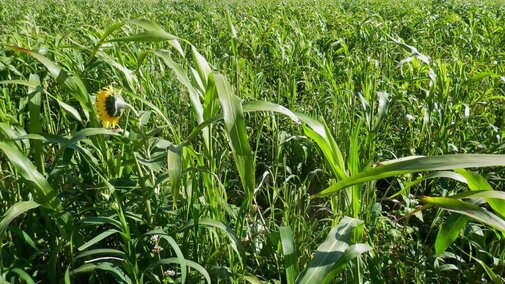This planting season, early dry conditions followed by late wet conditions in some areas have caused some fields to be designated prevented planting acres. To go along with this, high feed and forage prices and less than ideal pasture conditions due to previous years’ drought are allowing the opportunity for producers to think outside the box. After all, an influx of prevented plant acres provides freedom to produce annual cover crops to counterbalance current forage prices.
Prevented planting payment is subsidized by the U.S. Department of Agriculture Risk Management Agency on the first insured crop in the event that a second crop is not planted. If a corn grower reports prevented plant to their crop insurance agent, they can still receive full payment if the second crop planted is considered a cover crop that is not harvested for seed or grain. However, the cover crop can be utilized as a forage source and payment will not be reduced. For more information on this, reach out to your local Farm Service Agency (FSA) or Natural Resource Conservation Service (NRCS) to confirm approved mixes.
In years of adequate moisture, grazing cover crops creates opportunity to utilize cost savings by reducing mechanical harvest of stored forages while allowing recuperation of stressed pastures. Unlike mature, late summer/early fall range, cover crop mixes are nutrient dense when grazed at less mature stages.
Brassicas are a highly attractive option due to their high levels of crude protein and digestible carbohydrates. These varieties include turnips, rapeseed and kale and when planted in late July to early August provide phenomenal potential for late autumn grazing. However, due to their high nutrient quality along with containing low fiber levels, brassicas should make up . Interseeding brassicas with summer annuals or winter sensitive cool-season grasses helps ensure adequate fiber consumption, mitigating these issues.
If warm-season grasses such as teff, sorghum-sudangrasses or forage sorghum are desired, they should be planted by the middle of July to early August. Sorghum-sudangrasses possess the ability to three to four tons by early to middle September. Crimping the hay at mowing crushes the stems accelerating drying — especially important for thicker-stemmed sorghum species. Planting a stand on the higher end of recommended seeding rates also helps keep stem circumference down. To maximize quality and quantity of hay production, these forages should be mowed during the boot stage. Due to difficulty of drying these species later in the summer, another option would be to produce silage.
Sudangrasses are more accommodating to grazing than making hay. While they do lack in tonnage relative to their hybrid counterparts, their smaller stem will regrow after initial grazing, resulting in equivalent or greater yields when grazed. Another desirable feature of sudangrasses is the lowered risk of prussic acid poisoning than sorghum-sudangrass.
While this risk is lower, sudangrass should not be grazed until plants reach a height of 18 inches, as prussic acid is most concentrated in young growth. This rule should be applied to any regrowth as well. Strip-grazing sudangrass is a recommended practice if a whole field cannot be grazed all at once before plants start to produce regrowth. This allows for a recovery period during which the grazed portion of the field can recover while simultaneously preventing animals from consuming new shoots high in prussic acid.
Prussic acid may also be a risk later in the fall from fields experiencing a frost. Even mature plants that receive frost damage can release toxic amounts of prussic acid for several days. One surefire way to avoid prussic acid issues altogether is to utilize millet species instead. Pearl millet is a leafy forage that regrows well after grazing and yields equally to sudangrass without risking prussic acid poisoning. While it is a reasonably drought tolerable plant, its sensitivity to cool weather limits grazing potential to the hot days of late summer and cannot be counted on for late summer regrowth.
The Nebguide Summer Annual Forage Grasses provides tables with seeding rates, and the BeefWatch article Annual Forage Options for July and August Planting details considerations for choosing species and harvest methods for warm-season annuals planted later in the summer.
Cereal grains, such as oats, planted in mid- to late July can go to seed prior to being able to produce a high-quality forage due to late summer heat. However, these winter sensitive cool-season small grains will be high-quality if they are planted in mid- to late August. In fact, summer calving cows in peak lactation have been shown to gain BCS and 500 lb growing calves can gain 1-2 lb/d when grazing late summer planted oats in the fall. If planting is unable to occur until early September, a winter hardy cool-season annual such as barley or rye is recommended for early spring growth as fall growth will be inadequate to be cost-effective.
Those interested in using annual forages as a part of their forage plan each year may want to consider the option of purchasing an annual forage insurance plan. More info about planting and managing annual forages and the annual forage insurance plan are outlined in our recent webinar, Tips for making annual forages work for you.
For more information on utilizing cover crops for forages, contact Connor Biehler at 402-472-8007 or visit Big Red Beef Talk.

